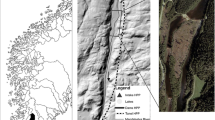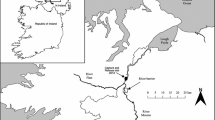Abstract
Estuarine nearshore environments are important habitats for many organisms, including juveniles of several Pacific salmon species (Oncorhynchus spp.). These habitats provide shallow water and high prey productivity, but are increasingly modified by anthropogenic activity including shoreline armoring, which disrupts connectivity between aquatic and terrestrial realms and artificially steepens the shore. Such effects may have adverse consequences for juvenile salmon, particularly Chinook (O. tshawytscha) and chum (O. nerka), which are known to rely on shallow, productive nearshore habitats for foraging and refuge from predators during their outmigration from natal streams to the sea. We developed snorkel methods to quantify feeding rates, movement rates, and path complexity of juvenile salmon along armored and unarmored shorelines in Puget Sound, WA, USA. We found that juvenile salmon had relatively high feeding rates along all shoreline types, but that path straightness and movement rates showed some variation between armored and unarmored sites. Feeding fish swam in more complex paths and were observed in larger schools than non-feeding fish, and path straightness and movement rate were negatively correlated with proportion of time feeding. Feeding behavior, school size, and movement rates also showed variation by species. Shoreline type (armored or unarmored) influenced juvenile salmon distribution, and unarmored shorelines appear to accommodate a greater diversity of movement patterns than armored shorelines. Our results show that juvenile salmon feed at high rates along armored and unarmored estuarine shorelines, thus decreased prey availability or altered prey resources are likely the most detrimental foraging effects of armoring in estuarine nearshore ecosystems.




Similar content being viewed by others
References
Able KW, Grothues TM, Kemp IM (2013) Fine-scale distribution of pelagic fishes relative to a large urban pier. Mar Ecol Prog Ser 476:185–198
Almeida PJAL, Vieira MV, Kajin M, Forero-Medina G, Cerqueira R (2010) Indices of movement behavior: conceptual background, effects of scale and location errors. Zoologia 27:674–680
Austin D, Bowen WD, McMillan JI, Iverson SJ (2006) Linking movement, diving, and habitat to foraging success in a large marine predator. Ecology 87:3095–3108
Beamish RJ, Mahnken C (2001) A critical size and period hypothesis to explain natural regulation of salmon abundance and the linkage to climate and climate change. Prog Oceanogr 49:423–437
Beauchamp DA, Cross AD, Armstrong JL, Myers KW, Moss JH, Boldt JL, Haldorson LJ (2007) Bioenergetic responses by Pacific salmon to climate and ecosystem variation. North Pac Anadromous Fish Comm Bull 4:257–296
Benhamou S (2004) How to reliably estimate the tortuosity of an animal’s path: straightness, sinuosity, or fractal dimension? J Theor Biol 229:209–220
Bilkovic DM, Roggero MM (2008) Effects of coastal development on nearshore estuarine nekton communities. Mar Ecol Prog Ser 358:27–39
Biro PA, Abrahams MV, Post JR (2007) Direct manipulation of behaviour reveals a mechanism for variation in growth and mortality among prey populations. Anim Behav 73:891–896
Charoy C, Clement P (1993) Foraging behavior of Brachionus calyciflorus (Pallas) - variations in the swimming path according to presence or absence of algal food (Chlorella). Hydrobiologia 255:95–100
Cordell JR, Toft JD, Gray A, Ruggerone GT, Cooksey M (2011) Functions of restored wetlands for juvenile salmon in an industrialized estuary. Ecol Eng 37:343–353
Cunjak RA, Power G (1986) Winter habitat utilization by stream resident brook trout (Salvelinus fontinalis) and brown trout (Salmo trutta). Can J Fish Aquat Sci 43:1970–1981
De Knegt HJ, Hengeveld GM, van Langevelde F, de Boer WF, Kirkman KP (2007) Patch density determines movement patterns and foraging efficiency of large herbivores. Behav Ecol 18:1065–1072
Dionne M, Dodson JJ (2002) Impact of exposure to a simulated predator (Mergus merganser) on the activity of juvenile Atlantic salmon (Salmo salar) in a natural environment. Can J Zool 80:2006–2013
Duffy EJ, Beauchamp DA (2008) Spatial patterns of predation on juvenile Pacific salmon by anadromous cutthroat trout in Puget Sound. Trans Am Fish Soc 137:165–181
Duffy EJ, Beauchamp DA (2011) Rapid growth in the early marine period improves the marine survival of Chinook salmon (Oncorhynchus tshawytscha) in Puget Sound, WA. Can J Fish Aquat Sci 68:232–240
Duffy EJ, Beauchamp DA, Buckley RM (2005) Early marine life history of juvenile Pacific salmon in two regions of Puget Sound. Estuar Coast Shelf Sci 64:94–107
Duffy EJ, Beauchamp DA, Sweeting RM, Beamish RJ, Brennan JS (2010) Ontogenetic diet shifts of juvenile Chinook salmon in nearshore and offshore habitats of Puget Sound. Trans Am Fish Soc 139:803–823
Duffy KJ, Dai XH, Shannon G, Slotow R, Page B (2011) Movement patterns of African elephants (Loxodonta africana) in different habitat types. S Afr J Wildl Res 41:21–28
Fryxell JM, Hazell M, Börger L, Dalziel BD, Haydon DT, Morales JM, McIntosh T, Rosatte RC (2008) Multiple movement modes by large herbivores at multiple spatiotemporal scales. Proc Natl Acad Sci 105:19114–19119
Healey MC (1982) Juvenile Pacific salmon in estuaries: the life support system. In: Kennedy VS (ed) Estuarine comparisons. Academic, New York, pp 315–341
Healy BD, Lonzarich DG (2000) Microhabitat use and behavior of overwintering juvenile coho salmon in a Lake Superior tributary. Trans Am Fish Soc 129:866–872
Heerhartz SM, Dethier MN, Toft JD, Cordell JR, Ogston AS (2014) Effects of shoreline armoring on beach wrack subsidies to the nearshore ecotone in an estuarine fjord. Estuar Coasts 37:1256–1268
Johnson LL, Ylitalo GM, Sloan CA, Anulacion BF, Kagley AN, Arkoosh MR, Lundrigan TA, Larson K, Siipola M, Collier TK (2007a) Persistent organic pollutants in outmigrant juvenile Chinook salmon from the Lower Columbia Estuary, USA. Sci Total Environ 374:342–366
Johnson LL, Ylitalo GM, Arkoosh MR, Kagley AN, Stafford C, Bolton JL, Buzitis J, Anulacion BF, Collier TK (2007b) Contaminant exposure in outmigrant juvenile salmon from Pacific Northwest estuaries of the United States. Environ Monit Assess 124:167–194
Levings CD, Conlin K, Raymond B (1991) Intertidal habitats used by juvenile Chinook salmon (Oncorhynchus tshawytscha) rearing in the north arm of the Fraser River estuary. Mar Pollut Bull 22:20–26
Loge FJ, Arkoosh MR, Ginn TR, Johnson LL, Collier TK (2005) Impact of environmental stressors on the dynamics of disease transmission. Environ Sci Technol 39:7329–7336
Magnusson A, Hilborn R (2003) Estuarine influence on survival rates of Coho (Oncorhynchus kisutch) and Chinook salmon (Oncorhynchus tshawytscha) released from hatcheries on the US Pacific Coast. Estuaries 26:1094–1103
McClure MM, Carlson SM, Beechie TJ, Pess GR, Jorgensen JC, Sogard SM, Sultan SE, Holzer DM, Travis J, Sanderson BL, Power ME, Carmichael RW (2008) Evolutionary consequences of habitat loss for Pacific anadromous salmonids. Evol Appl 1:300–318
McIntyre NE, Wiens JA (1999) Interactions between landscape structure and animal behavior: the roles of heterogeneously distributed resources and food deprivation on movement patterns. Landsc Ecol 14:437–447
Miller JA, Teel DJ, Baptista A, Morgan CA (2013) Disentangling bottom-up and top-down effects on survival during early ocean residence in a population of Chinook salmon (Oncorhynchus tshawytscha). Can J Fish Aquat Sci 70:617–629
Mortensen D, Wertheimer A, Taylor S, Landingham G (2000) The relation between early marine growth of pink salmon, Oncorhynchus gorbuscha, and marine water temperature, secondary production, and survival to adulthood. Fish B-NOAA 98:319–335
Munsch SH, Cordell JR, Toft JD, Morgan EE (2014) Effects of seawalls and piers on fish assemblages and juvenile salmon feeding behavior. North Am J Fish Manag 34:814–827
Ono K, Simenstad CA (2014) Reducing the effect of overwater structures on migrating juvenile salmon: an experiment with light. Ecol Eng 71:180–189
Pedersen MW, Patterson TA, Thygesen UH, Madsen H (2011) Estimating animal behavior and residency from movement data. Oikos 120:1281–1290
Romanuk TN, Levings CD (2003) Associations between arthropods and supra-littoral ecotone: dependence of aquatic and terrestrial taxa on riparian vegetation. Environ Entomol 32:1343–1353
Romanuk TN, Levings CD (2005) Stable isotope analysis of trophic position and terrestrial vs. marine carbon sources for juvenile Pacific salmonids in nearshore marine habitats. Fish Manag Ecol 12:113–121
Semmens BX (2008) Acoustically derived fine-scale behaviors of juvenile Chinook salmon (Oncorhynchus tshawytscha) associated with intertidal benthic habitats in an estuary. Can J Fish Aquat Sci 65:2053–2062
Sergeant CJ, Beauchamp DA (2006) Effects of physical habitat and ontogeny on lentic habitat preferences of juvenile Chinook salmon. Trans Am Fish Soc 135:1191–1204
Shaffer JA, Beirne M, Ritchie T, Paradis R, Barry D, Crain P (2009) Fish habitat use response to anthropogenic induced changes of physical processes in the Elwha estuary, Washington, USA. Hydrobiologia 636:179–190
Simenstad CA, Fresh KL, Salo EO (1982) The role of Puget Sound estuaries in the life history of Pacific salmon: an unappreciated function. In: Kennedy VS (ed) Estuarine comparisons. Academic, New York, pp 343–364
Simmons RK, Quinn TP, Seeb LW, Schindler DE, Hilborn R (2013) Role of estuarine rearing for sockeye salmon in Alaska (USA). Mar Ecol Prog Ser 481:211–223
Sobocinski KL, Cordell JR, Simenstad CA (2010) Effects of shoreline modifications on supratidal macroinvertebrate fauna on Puget Sound, Washington beaches. Estuar Coasts 33:699–711
Stein JE, Hom T, Collier TK, Brown DW, Varanasi U (1995) Contaminant exposure and biochemical effects in outmigrant juvenile Chinook salmon from urban and nonurban estuaries of Puget Sound, Washington. Environ Toxicol Chem 14:1019–1029
Thorpe JE (1994) Salmonid fishes and the estuarine environment. Estuaries 17:76–93
Toft JD, Cordell JR, Simenstad CA, Stamatiou LA (2007) Fish distribution, abundance, and behavior along city shoreline types in Puget Sound. North Am J Fish Manag 27:465–480
Toft JD, Ogston AS, Heerhartz SM, Cordell JR, Flemer EE (2013) Ecological response and physical stability of habitat enhancements along an urban armored shoreline. Ecol Eng 57:97–108
Willette TH (2001) Foraging behaviour of juvenile pink salmon (Oncorhynchus gorbuscha) and size-dependent predation risk. Fish Oceanogr 10:110–131
Wilson RP, Liebsch N, Davies IM, Quintana F, Weimerskirch H, Storch S, Lucke K, Siebert U, Zankl S, Müller G, Zimmer I, Scolaro A, Campagna C, Plötz J, Bornemann H, Teilmann J, McMahon CR (2007) All at sea with animal tracks; methodological and analytical solutions for the resolution of movement. Deep-Sea Res Pt II 54:193–210
Wissmar RC, Simenstad CA (1988) Energetic constraints of juvenile chum salmon (Onchorhynchus keta) migrating in estuaries. Can J Fish Aquat Sci 45:1555–1560
Young CD (2009) Shoaling behavior as a tool to understand microhabitat use by juvenile chum salmon, Oncorhynchus keta. Dissertation, University of Washington
Acknowledgments
We thank members of the Wetland Ecosystem Team, especially Claire Levy, Beth Armbrust, Erin Morgan, Lia Stamatiou, and Katie Dowell for assistance with field work. Thanks to Mary Ramirez and Erin Morgan for assistance with processing movement path data in ArcGIS and map creation. Charles Simenstad and Megan Dethier provided valuable reviews of this manuscript prior to submission. We thank Washington Sea Grant, the University of Washington School of Aquatic & Fishery Sciences, the Seattle Art Museum, the City of Seattle, and Seattle Public Utilities for supporting this research.
All applicable international, national, and institutional guidelines for the care and use of animals were followed. All fish surveys performed in this study were in accordance with the ethical standards of the University of Washington.
Author information
Authors and Affiliations
Corresponding author
Rights and permissions
About this article
Cite this article
Heerhartz, S.M., Toft, J.D. Movement patterns and feeding behavior of juvenile salmon (Oncorhynchus spp.) along armored and unarmored estuarine shorelines. Environ Biol Fish 98, 1501–1511 (2015). https://doi.org/10.1007/s10641-015-0377-5
Received:
Accepted:
Published:
Issue Date:
DOI: https://doi.org/10.1007/s10641-015-0377-5




